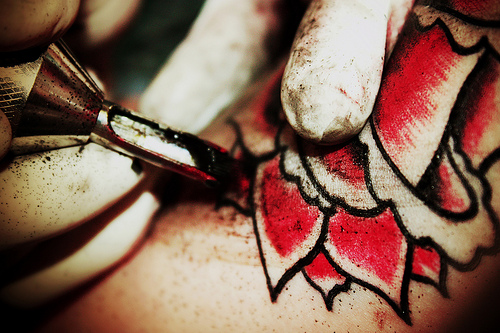Outlining is the first step in the tattoo process. It’s the first time you’ll actually place your art on someone else’s skin. Getting it right is crucial to the success of the rest of the tattoo. If it goes wrong it will show in the final results. The way you outline your tattoo and the depth of your needle are the two main factors in the sort of finish your client ends up with.
Needle depth is especially important. The depth of the needle determines how many layers of skin the color penetrates. A needle with more depth will create a darker and more long-lasting tattoo.
1. Difference Between Outlining and Shading
Most tattooists prefer to buy a separate lining and shading machine from a supplier like Tattools. There’s no issue with simply configuring one machine for outlining and shading, though. If you want to configure your own machine, bear these specifications in mind to make sure you get it right. This isn’t recommended for novice tattoo artists.
For outlining, a tattoo artist needs a depth of about 1mm to create a solid outline and lettering. Any less will reduce the durability of the tattoo and cause it to fade faster. Anything more just isn’t needed. Always use a round liner needle for this. Shaders use more needles with a depth of about half a millimeter.
Sometimes, you will get the depth of your needle wrong. This is why it’s best to underestimate the necessary depth. If it’s too light, you can easily go over it again with a deeper needle. It will make the job last longer, but at least you won’t mess up your client’s tattoo.
2. Skin Thickness
Everything hinges on the thickness of a client’s skin. The specifications for needle depth given above are only average measurements. People with thicker or thinner skins will warrant some slight adjustments to the machine. In the beginning, judging the thickness of someone’s skin is a hassle, which is why younger artists should double-check their specifications with a veteran before proceeding with their work.
Experience helps you judge the specifications. It’s easy to know how a petit 21-year-old lady will need less needle depth than a 300-pound bodybuilder in his mid-30s. The difficulty comes in spotting everything in between.
3. Practicing
Like with anything, becoming a master is all about practicing the art of tattooing. To get a feel for what each type of needle depth can do, use a substitute for human skin. Some apprentices pick up a bag of grapefruits from the store. Whilst the texture doesn’t match human skin, the depth does.
A better, but more expensive, alternative is to ask the butcher for some pig skin. Not every butcher will have any for sale, but bigger ones will. Pig skin is the closest match to human skin. It’s why scientists use it in experiments where human testing isn’t allowed. Over time, you’ll learn to spot the correct depth simply by looking at the person. Expect the process to take years, though.
Samuel is a former tattoo artist and enthusiast. Today, he spends his time training young apprentice tattooists in his local area. In his spare time, he writes articles on how to improve as a tattoo artist.He also writes for Tattools.







